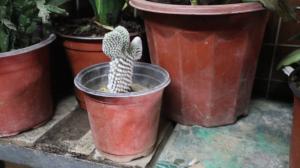How to Winterize a Pitcher Plant in a Pot
Winter can be a challenging time for pitcher plants in pots since they can be more vulnerable to injury from extreme cold, fluctuating temperatures, and dry indoor air. To ensure the survival of your pitcher plant, it is essential to take some necessary steps to make it through the winter. In this article, we will discuss some essential tips on how to winterize a pitcher plant in a pot.
Choose the Right Location
The first step in winterizing your pitcher plant is to choose the ideal location for it. The location you choose should be cool but above freezing temperature, and it should be bright enough to provide at least some natural light. Ideally, the temperature should be around 45 to 50 degrees Fahrenheit. If you don't have an ideal location indoors, you may want to consider a spot in your garage or basement that meets these temperature conditions.
Reduce Watering
During winter, pitcher plants go dormant, and their growth slows down. You need to adjust your watering routine accordingly. Since their soil will dry out less frequently, you should reduce watering frequency, but be careful not to let the soil dry out completely. A good rule of thumb is to let the soil dry out between watering. Avoid wetting the leaves and pitchers since it can cause fungal problems.
Provide Humidity
Indoor air during winter can be extremely dry, especially when you are heating your home. This dry air can damage your pitcher plant, so it is necessary to provide adequate humidity. You can place a tray of water near the plant, or you can mist the plant once a day with water to increase humidity. Another option is to use a humidifier to maintain the humidity level in the room.
Minimal Fertilization
During the winter, your pitcher plant's growth will slow down, and it may not need as much fertilizer as it does during the growing season. Be cautious not to over-fertilize or risk burning the roots, especially if your plant is sensitive to fertilizers. A little organic fertilizer may be beneficial to keep the soil fed, but avoid chemical-based fertilizers, which can be too harsh for these types of plants.
Protect from Cold Weather
If the temperature in your area is prone to drop below the ideal range for pitcher plants, you should take some extra precautions to protect your plant from cold weather. Consider placing some insulation around the pot, like foam or bubble wrap, to keep the roots warm. You can also cover the plant using a frost blanket or burlap, which helps to trap in heat and protect it from cold winds. Alternatively, you can move the plant indoors to a warmer location for the season.
Conclusion
Winterizing your pitcher plant can seem like a daunting task, but with some care and attention, it can thrive through the winter months. Remember to choose the right location, reduce watering, provide humidity, minimal fertilization, and protect from cold, and your pitcher plant should come out on the other side looking healthy and strong.

 how many times do yo...
how many times do yo... how many planted tre...
how many planted tre... how many pine trees ...
how many pine trees ... how many pecan trees...
how many pecan trees... how many plants comp...
how many plants comp... how many plants can ...
how many plants can ... how many plants and ...
how many plants and ... how many pepper plan...
how many pepper plan...






























